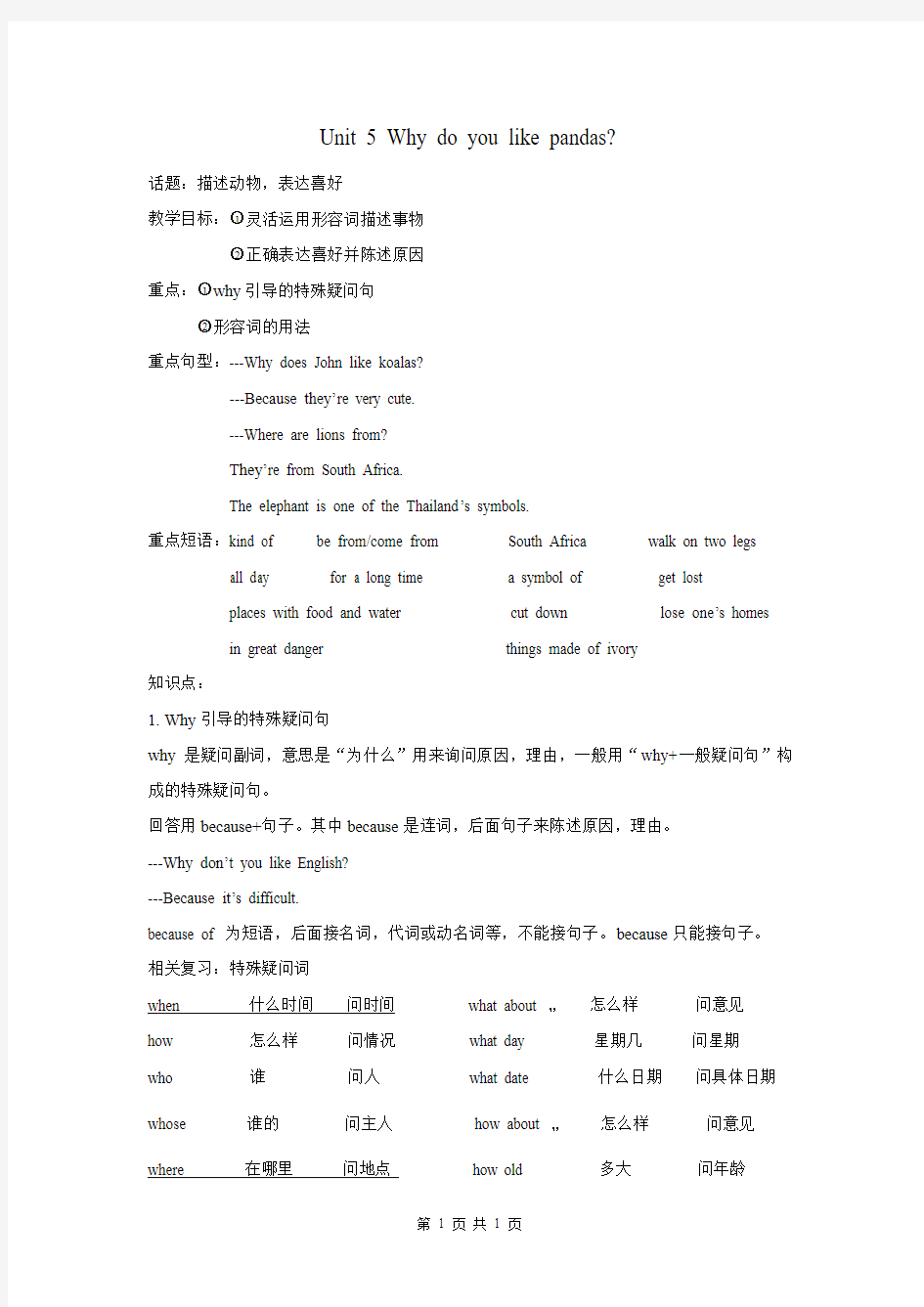七年级下册英语第5单元知识讲解以及随堂练习


Unit 5 Why do you like pandas?
话题:描述动物,表达喜好
教学目标:○1灵活运用形容词描述事物
○2正确表达喜好并陈述原因
重点:○1why引导的特殊疑问句
○2形容词的用法
重点句型:---Why does John like koalas?
---Because they’re very cute.
---Where are lions from?
They’re from South Africa.
The elephant is one of the Thailand’s symbols.
重点短语:kind of be from/come from South Africa walk on two legs all day for a long time a symbol of get lost
places with food and water cut down lose one’s homes
in great danger things made of ivory
知识点:
1.Why引导的特殊疑问句
why是疑问副词,意思是“为什么”用来询问原因,理由,一般用“why+一般疑问句”构成的特殊疑问句。
回答用because+句子。其中because是连词,后面句子来陈述原因,理由。
---Why don’t you like English?
---Because it’s difficult.
because of 为短语,后面接名词,代词或动名词等,不能接句子。because只能接句子。
相关复习:特殊疑问词
when 什么时间问时间what about …怎么样问意见
how 怎么样问情况what day 星期几问星期
who 谁问人what date 什么日期问具体日期whose 谁的问主人how about …怎么样问意见where 在哪里问地点how old 多大问年龄
which 哪一个 问选择 how many 多少(可数名词) 问数量 why 为什么 问原因 how much 多少(不可数名词) 问价钱 what 什么 问东西 how far 多远 问路程 what time 什么时间 问时间 what color 什么颜色 问颜色
2. 形容词
形容词用来修饰名词,用以说明人或物的形式或特征。形容词是英语中最常用的词性之一,它通常在句中作定语,表语等。
○
1作定语 用于修饰名词或代词,位于名词或代词前面。 This is an old book.
○
2作表语 放在连系动词后,作表语,构成系表结构,说明主语怎么样,即说明主语的特征。 They are cute.
3. Let ’s see the pandas first. 我们先看熊猫吧。 let ’s do sth. 让我们做某事吧,表示说话人的建议。 肯定回答有:
OK./ All right./ Good idea. 否定回答为:Sorry, I …. 提出建议的句型还有: 辨析let ’s&let us
Let ’s
包括说话者和对方在内,用来表示建议
Let ’s go to school, Daming. 让我们去上学吧。 Let us
不包括对方,用来表示请求
Let us go home, Mr. Wang.
shall we/I+动原…? Let's +动原…?
How about /what about+doing? You'd better (not)do … Why not+动词原形 Why don't you+其他
王老师,让我们回家吧。3.favorite
favorite 形容词,意思是“最喜爱的,特别喜爱的”可与like…best互换。
What’s one’s favorite=What…does sb. like best?
favorite还可以作名词,意为“最喜欢的人或事物”
Football is my favorite.
4.cute&smart&clever
The cat Kitty is very cute. cute 侧重“可爱”,多用来形容动
物,指某种东西因小巧玲珑而
可爱
smart 侧重“顽皮”。指人时,多指
He is a smart business.
思维能力很强,办事巧妙。还
可指人的外部形象“潇洒,时
髦”
He is a clever student.
clever 侧重“有头脑的”,多指人或
动物的脑子灵活,理解事物
快。
5.fun&interesting
fun 好玩的,令人愉快的It’s fun to go shopping and
look at thins everywhere. interesting 着重强调事物本身有趣The film is very interesting. 6.kind of
kind of是非常口语化的表达方式,意思是“稍微,有点儿”,用来修饰形容词。
The little tiger is kind of dangerous. 这只小老虎有点儿危险。
kind作名词,意为“种类,类型,类别”,可构成短语:a kind of…一种all kinds of各种各样的different kinds of 不同种类的
kind 还可以作形容词,意为“和蔼的,亲切的”
Our teacher is kind to us. 我们老师对我们很好。
常用句型
It’s kind of you to help me. 你帮助我真是太好了。
7.like
Like喜欢,后可接名词,代词,动词不定式或动名词作宾语。
eg. Do you like coffee?
like还可以作介词,意为“像,相似”
含有like的固定短语:
○1look like 看起来像
eg. What does you mother look like?
○2feel like doing sth. 想要做某事
I feel like taking a rest. 我想休息一会。
○3would like sth./to do sth. 想要做某事
Would you like some orange juice?
○4would like sb. to do sth.
I’d like you to meet a friend of mine.
我想让你见我的一位朋友。
8.Where are you from?它们来自哪里?
此句是Where引导的特殊疑问句,即Where+be+主语+from句型,回答时,介词from后常跟表示国家,城市等的地点名词。对Where引导的特殊疑问句我们应根据实际情况作答。be from 意为“从……来,来自……同义短语为come from
9.sleep
sleep 指睡觉,睡着的全过程,强调睡眠的持续状态。I sleep eight hours a day.
go to bed 指上床睡觉,强调上床睡觉这一动作,但不一定睡着,与get up起床相对。eg. It’s time to go to bed.
与睡觉相关的短语:
feel asleep 感到困倦
go to bed 上床睡觉
fall asleep/to to sleep 入睡
be asleep/sleeping睡着了
wake up 醒来
be awake 醒着的
10.friendly
形容词,友好的,其反义词为unfriendly 不友好的。
The old woman is very friendly. 那位老妇人非常友好。
be friendly to 对某人友好
be friendly with 和某人关系好
eg. The classmates in our class are friendly with each other.
11.small&little&young
small 指物体在形状外型上小It is a small house.
My cousin is a little boy.
little 带有一定的感情色彩,有可爱
之意
young 指在年龄上小,意为“年轻的”As a young man, he is very
polite to the old people.
12.from
○1from…to…从……到……表时间或地点
from house to house 挨家挨户
from time to time 不时地
from day to day 一天天地
○2be far from 离……远
Her house is far from our school. 她的家离我们学校很远。
13.danger
danger名词危险常用短语in great danger 处于危险之中be out of danger 脱离危险
形容词为dangerous 危险的
eg. The river is dangerous for swimmers.
14.Today there are only about 3,000 elephants (over 100,0)00 before).
over 此处作介词,意为超过,多于,相当于more than.
There are over fifty students in our class.
over还可以表示在……上方
There is a bridge over the river. 河上有座桥。
over 还可以作副词,表示完了,结束
Class is over. 下课了。
常用短语:
go over 检查all over 遍及,整个over and over 反复over there 在那边
15.We must save the trees and not buy things made of ivory.
过去分词短语made of作后置定语,修饰其前的名词things. made of意为“由……制成”
be made of 从制成品中能看出原材料。
be made from 从制成品中看不出原材料。
eg. The kite is made of paper.
Butter is made from milk.
16.Isn’t she beautiful? 她难道不美丽吗?
这是一个否定的一般疑问句。常用来表示反问,责备,或表示说话人的看法或惊异的情绪,意思是“难道……不……嘛?”其结构是“连系动词be/助动词/情态动词的否定形式+主语+其他?”
Aren’t you American? 难道你不是美国人吗?
回答否定的一般疑问句时,如果是肯定回答,用Yes开头,如果是否定回答,用No开头。但是翻译成汉语时Yes意为“不”No意为“是的”
---Doesn’t he have a brother? 难道他没有兄弟吗?
--Yes, he does. 不,他有。
17.数词+years old&数词+year-old
数词+years old 作表语His daughter is two years old. 数词+year-old 作前置定语He has a two-year-old
daughter.
